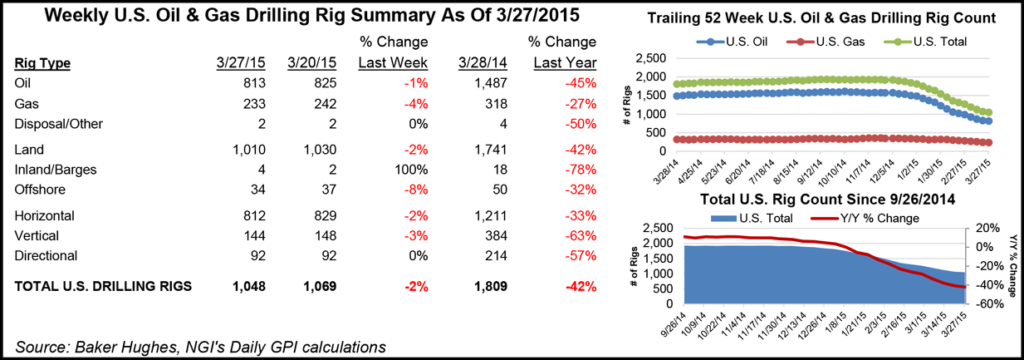E&P | NGI All News Access | NGI The Weekly Gas Market Report
Rigs Still Departing, But Not Quite in Such A Hurry
If a CEO throws a drill bit out his office window — and who knows, these days one might — it will fall at an increasing rate dictated by the acceleration of gravity. Galileo figured that out. Rig counts fall, too, but unlike any drill bit thrown in exasperation, their pace of descent can slow.

The Baker Hughes U.S. count of operating rotary rigs fell again in the company’s Friday tally, but it would appear that the pace of decline is decelerating nationwide — and in some key producing states.
The nationwide count was down 21 from the week before at 1,048. The previous weekly count saw a decline of 56 rigs, and the one before that 67.
Texas only lost three rigs to rest at 462. The week before, the Lone Star State’s count was down by 36, and fell by 37 the week before that. Louisiana also only lost three to rest at 72. The week-ago count found the Pelican State down by 18 after having lost seven the week before that.
North Dakota was down two to 96 after dropping three rigs in the previous count to bust through the 100-rig level and land at 98. Ohio held steady for the week at 28, and Pennsylvania added a rig to rest at 51 after dropping three in the previous count. Colorado was down two to 37, which is where it was two weeks prior in the March 13 survey.
The Canadians also seemed to have slowed their drilling pullback, losing 20 rigs in the latest count to rest at 120. But that is a far smaller decline than drops of 80 in each of the two previous weeks.
In Canada and the United States, oil- and gas-directed rigs both saw their ranks pared. Canada now has only 18 gas rigs running but 102 targeting oil. The story changes south of the border with nearly three and a half times as many rigs targeting oil than gas. Horizontal rigs lost more in number last week (down 17 to 812), but their ranks are stronger at 812 compared with 144 vertical rigs.
© 2024 Natural Gas Intelligence. All rights reserved.
ISSN © 1532-1231 | ISSN © 2577-9877 | ISSN © 1532-1266 |
